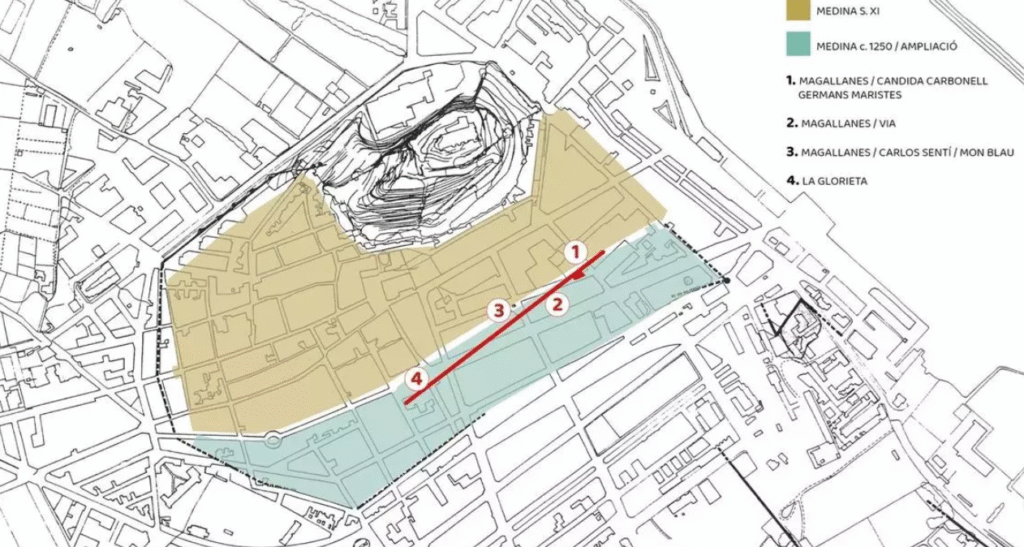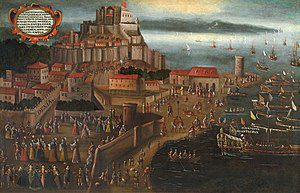Dénia’s History
Dénia is a historical coastal city in the district of Marina Alta in the province of Alicante, Comunidad Valenciana, Spain. The seashore is known as the Costa Blanca (White Coast), halfway between the cities of Alicante and Valencia. Dénia’s historical heritage has been influenced by Iberian, Phoenician, Roman, Islamic and Christian civilizations. The population as of 2024 was around 47,000. This figure more than quadrupled during the Summer months.
There is evidence of human habitation in the area since prehistoric times, and significant Iberian ruins can be found on the surrounding hillsides. In the 4th century BC, a Greek colony is believed to have existed in the area, possibly the one referred to by the Greek geographer Strabo as Hēmeroskopeion (meaning “watchtower”), although no archaeological evidence has confirmed its location.
Rising to 753 meters near Dénia, Mount Montgó was a striking natural landmark visible from afar. Since Roman times, it is thought to have served both as a navigational aid for incoming vessels and as a strategic watchpoint along the coast. Its elevated position was also ideal for monitoring passing ships and spotting schools of migrating tuna, making it a strategic center for fishing activities. A temple dedicated to Ártemis Efesia, Greek godess of the hunt, the wilderness, wild animals, nature, vegetation and childbirth was reported to exist in The Montgó. No archeological evidence of this temple or of an important Greek settlement in this area have ever taken place.
The name of the city of Dénia originates from the Roman settlement Dianium, which was named after the Roman goddess Diana, equivalent to the Greek goddess Artemis. The Romans established the colony in the 1st century BC, and its name reflects the worship of Diana, possibly due to a sanctuary or cult dedicated to her in the area. In the 1st century BC, Quintus Sertorius (122-72 BC) established a roman naval base operating from its port. Over time, the name evolved linguistically into its modern form, Dénia.
The new city reached great importance due to its port. Between the first half of the Ist century BC and the mid II century AD, Dianium experienced an economic boom with large slaveholders, Vilas dedicated to the production of wine and oil, exported their products to Gaul, Liguria and Rome. This period is the start of production of amphorae and tiles in the roman Vila of Almadrava. It is believed that prestigious buildings such as public baths, a theater or a circus existed here.
In the late 4th century, the Roman Empire was divided into two, the Western and the Eastern Empires, and barbarians occupied Hispania. In the year 472 AD , the Western Empire collapsed. In 624 AD, Hispania was conquered by the Visigoths. After the decline of the Roman Empire, the Visigoths ruled Dénia for a short period from 636 to 696 AD. Later on, the Muslims conquered most of the Iberian peninsula including Dénia, in arabic Dāniyya. Dénia was ruled by the Caliphate of Cordoba with the consequent Islamization and Arabization of the Iberic peninsula. At that time, the port and commercial activities in Dénia declined to be barely a haven for pirates. When the Caliphate disintegrated (1010 AD), Dénia was the capital of the muslim Tarifa Kingdom of Dénia (1037 AD) that reigned over part of the Valencian coast and the Balearic islands. At this time the citadel of the castle, a mosque, baths and Ravales (suburbs) outside the walls were built. It is a time of splendor in which Dénia buzzes with cultural vitality, even minting its own currency.

Map of Dénia (Dāniyya) during the Arab period (circa 1037–1250), showing the populated
area (highlighted in color), the castle, and the city walls.
In 1076, Dénia was captured by Ahmad al-Muqtadir, the ruler of Zaragoza, under whose control it remained until the Almoravid invasion in 1091, which sought to reunify Al-Andalus. In 1238, the King Jaume I conquered the city of Valencia, and a few years later, in 1244, the city was captured in his name by the Knight Pedro Ximénez de Carrós. The king granted the city extensive franchises and privileges, considering it an important possession of the crown. Dénia was repopulated by the Valencian government. It was converted into a county by Pedro The Ceremonious in 1356.
The city was incorporated into the Crown of Aragon in 1455 and was later elevated to a marquisate by the Catholic Monarchs in 1487. That same year, Diego Gómez de Sandoval y Rojas was appointed the 1st Marquis of Dénia by Ferdinand the Catholic.
In 1580, the renowned writer Miguel de Cervantes y Saavedra (1547-1616), who had not yet written Don Quixote of La Mancha (published in 1605), landed in Dénia after his captivity by Barbary pirates in Algiers. In 1604, the Convent of Our Lady of Loreto, of the Augustinian nuns, was founded at the intersection of Calle Loreto and Sant Narcís. The king Philip III (1578-1621) visited Dénia several times, staying at the residence of his favorite, Francisco Gómez de Sandoval y Rojas (1552-1625), 5th Marquis of Dénia and Duke of Lerma. The county remained under the control of the Sandoval family for generations. In 1609 the Duke of Lerma, promoted the expulsion of the Moriscos through the port of Dénia, bound for Oran. The Moriscos were Muslims from Al-Andalus who had been forced to convert to Catholicism. The city suffered a further period of decline after the decree of Expulsion of the Moriscos (1609), by which 25,000 people or 40,000 by other sources, left the marquisate, leaving the local economy in a dismal state. In 1612, Philip III granted Dénia the title of City.

During the War of the Spanish Succession (1701-1713), Dénia was the first city in Aragon to proclaim Archduke Charles king. After the Battle of Almansa, only Alcoy, Alicante, and Dénia remained in the hands of the Austrians. Philip V ordered the French general D’Asfeld to take these cities. On June 27, 1707, he began the siege of Dénia with an army of 9,000 men (Other sources indicate 12,000 men). However, since the city could not be blocked by sea, due to the Castle location, it was impossible to prevent aid entering from Barcelona. The French attempted an assault three times failing all of them, so D’Asfeld lifted the siege after 27 days and began the march toward Valencia. However, after the surrender of Alcoy on January 9, 1708, General D’Asfeld once again besieged the city. The civilian population of Dénia fled to the Balearic Islands. On November 12, a general assault led to the capture of the city, and the besieged retreated to the castle, where they awaited relief by sea. This communication was cut off by Marshal Pedro Ronquillo. On November 17 it fell to the French forces, causing large material destruction. A capitulation was signed. All prisoners were sent to Castile. In 1713 the Treaty of Utrecht recognized Louis XIV’s grandson Philip, Duke of Anjou, as King of Spain under the name of Philip V, so returning Dénia to Spanish rule.
During the War of the Spanish Succession, the Castle’s Vila Vella was razed and destroyed by the troops of Philip V. The palace of the Marquis of Dénia, or the Old Palace, was demolished and dismantled, its heights cut down, and all traces of its former urban and palatial life disappeared. The castle remained a stronghold for exclusive military use, and as such, it was equipped with fortified defenses and armed bastions.
The Church of the Assumption of Dénia was built between 1744 and 1765 on the site where the Hermitage of Sant Roc had stood since the 15th century, in the Arrabal de la Vila district of Dénia. Built in the Baroque Neoclassical style, it is located in the Plaza de la Constitución, right next to the Town Hall.
On the morning of March 16, 1799, the frigate Guadalupe ran aground between Punta del Sard and Punta Negra, in the Les Rotes area, while fleeing from English ships. Of the 327 crew members, 147 lost their lives. This tragedy exposed the negligence of the local authorities and prompted a Royal Order from Charles IV in 1803 to reincorporate the port, the town, and the city of Dénia into the Crown. As a result, Dénia began to assume an increasingly significant role as a commercial port. In 1804, the Marquisate of Dénia was officially dissolved when Charles IV integrated the city fully into the royal domain.
A community of English raisin traders established in Dénia from 1800 until the time of the Spanish Civil War in the late 1930’s. At the beginning of the 20th century, the vineyards of Dénia were struck by a phylloxera outbreak caused by an insect parasite of the vine (Daktulosphaira vitifoliae). As a result, Dénia gradually abandoned the raisin industry, and the toy factories that would come to define the city during the first half of the century began to flourish.
During the Spanish Civil War (1936–1939), Dénia remained on the Republican side. Its location in the rearguard allowed the city to experience the conflict with relative normality, if not for the repeated bombings and the constant sound of air raid sirens warning of German and Italian aircraft flying over the municipality. On October 18, 1938, Dénia was directly bombed: 44 bombs were dropped, targeting the docks, the esplanade, and the warehouses. However, many bombs struck La Vía street instead, causing extensive damage and resulting in fourteen deaths and fifty injured. Between August 13, 1937, and March 28, 1939, a total of 32 people lost their lives in Dénia due to aerial bombings.
In the 1960’s the city was no stranger to its tourist attractions and became a focus of national and international tourism, an industry that still exists in the city today. Dénia is today an important touristic destination of the Costa Blanca in the province of Alicante, where thousands of visitors from Spain and abroad enjoy the city, its beaches, its Mediterranean cuisine and its history and culture. Now, you are part of its 24 centuries of history
